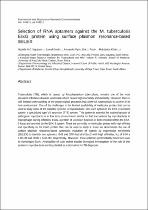 ResearchSpace
ResearchSpace
Selection of RNA aptamers against the M. tuberculosis EsxG protein using surface plasmon resonance-based SELEX
JavaScript is disabled for your browser. Some features of this site may not work without it.
- ResearchSpace
- →
- Research Publications/Outputs
- →
- Journal Articles
- →
- View Item
| dc.contributor.author |
Ngubane, NAC

|
|
| dc.contributor.author |
Gresh, L

|
|
| dc.contributor.author |
Pymb, A

|
|
| dc.contributor.author |
Rubin, EJ

|
|
| dc.contributor.author |
Khati, M

|
|
| dc.date.accessioned | 2014-07-30T10:41:27Z | |
| dc.date.available | 2014-07-30T10:41:27Z | |
| dc.date.issued | 2014-06 | |
| dc.identifier.citation | Ngubane, N.A.C, Gresh, L, Pymb, A, Rubin, E.J and Khati, M. 2014. Selection of RNA aptamers against the M. tuberculosis EsxG protein using surface plasmon resonance-based SELEX. Biochemical and Biophysical Research Communications, vol. 449(1), pp 114-119 | en_US |
| dc.identifier.issn | 0006-291X | |
| dc.identifier.uri | http://ac.els-cdn.com/S0006291X14008420/1-s2.0-S0006291X14008420-main.pdf?_tid=adf20c16-17cc-11e4-a0da-00000aab0f01&acdnat=1406713038_c2cf1d8d5192ea0e59e39dffeb54946f | |
| dc.identifier.uri | http://hdl.handle.net/10204/7551 | |
| dc.description | Copyright: 2014 Elsevier. This is an ABSTRACT ONLY. The definitive version is published in Biochemical and Biophysical Research Communications, vol. 449(1), pp 114-119 | en_US |
| dc.description.abstract | Tuberculosis (TB), which is caused by Mycobacterium tuberculosis, remains one of the most prevalent infectious diseases worldwide which causes high morbidity and mortality. However, there is still limited understanding of the physiological processes that allow M. tuberculosis to survive in its host environment. One of the challenges is the limited availability of molecular probes that can be used to study some of the complex systems in mycobacteria. One such system is the ESX-3 secretion system, a specialized type VII secretion (T7S) system. This system is essential for optimal growth of pathogenic mycobacteria in low iron environments similar to that encountered by mycobacteria in macrophages during infection. EsxG, a protein of unknown function, is both encoded within the ESX-3 locus and secreted by the ESX-3 system. There are currently no molecular probes with high affinity and specificity to the EsxG protein that can be used to study it. Here we demonstrate the use of surface plasmon resonance-based systematic evolution of ligands by exponential enrichment (SELEX) to identify two aptamers, G43 and G78 that bind EsxG with high affinities, K(subD) of 8.04 ± 1.90 nM and 78.85 ± 9.40 nM, respectively. Moreover, these aptamers preferentially bind EsxG over its homologue EsxA. Availability of such probes enables biological investigation of the role of this protein in mycobacteria and its potential as a biomarker for TB diagnosis. | en_US |
| dc.language.iso | en | en_US |
| dc.publisher | Elsevier | en_US |
| dc.relation.ispartofseries | Workflow;13156 | |
| dc.subject | M. tuberculosis | en_US |
| dc.subject | Systematic evolution of ligands by exponential enrichment | en_US |
| dc.subject | SELEX | en_US |
| dc.subject | Aptamer | en_US |
| dc.subject | EsxG | en_US |
| dc.title | Selection of RNA aptamers against the M. tuberculosis EsxG protein using surface plasmon resonance-based SELEX | en_US |
| dc.type | Article | en_US |
| dc.identifier.apacitation | Ngubane, N., Gresh, L., Pymb, A., Rubin, E., & Khati, M. (2014). Selection of RNA aptamers against the M. tuberculosis EsxG protein using surface plasmon resonance-based SELEX. http://hdl.handle.net/10204/7551 | en_ZA |
| dc.identifier.chicagocitation | Ngubane, NAC, L Gresh, A Pymb, EJ Rubin, and M Khati "Selection of RNA aptamers against the M. tuberculosis EsxG protein using surface plasmon resonance-based SELEX." (2014) http://hdl.handle.net/10204/7551 | en_ZA |
| dc.identifier.vancouvercitation | Ngubane N, Gresh L, Pymb A, Rubin E, Khati M. Selection of RNA aptamers against the M. tuberculosis EsxG protein using surface plasmon resonance-based SELEX. 2014; http://hdl.handle.net/10204/7551. | en_ZA |
| dc.identifier.ris | TY - Article AU - Ngubane, NAC AU - Gresh, L AU - Pymb, A AU - Rubin, EJ AU - Khati, M AB - Tuberculosis (TB), which is caused by Mycobacterium tuberculosis, remains one of the most prevalent infectious diseases worldwide which causes high morbidity and mortality. However, there is still limited understanding of the physiological processes that allow M. tuberculosis to survive in its host environment. One of the challenges is the limited availability of molecular probes that can be used to study some of the complex systems in mycobacteria. One such system is the ESX-3 secretion system, a specialized type VII secretion (T7S) system. This system is essential for optimal growth of pathogenic mycobacteria in low iron environments similar to that encountered by mycobacteria in macrophages during infection. EsxG, a protein of unknown function, is both encoded within the ESX-3 locus and secreted by the ESX-3 system. There are currently no molecular probes with high affinity and specificity to the EsxG protein that can be used to study it. Here we demonstrate the use of surface plasmon resonance-based systematic evolution of ligands by exponential enrichment (SELEX) to identify two aptamers, G43 and G78 that bind EsxG with high affinities, K(subD) of 8.04 ± 1.90 nM and 78.85 ± 9.40 nM, respectively. Moreover, these aptamers preferentially bind EsxG over its homologue EsxA. Availability of such probes enables biological investigation of the role of this protein in mycobacteria and its potential as a biomarker for TB diagnosis. DA - 2014-06 DB - ResearchSpace DP - CSIR KW - M. tuberculosis KW - Systematic evolution of ligands by exponential enrichment KW - SELEX KW - Aptamer KW - EsxG LK - https://researchspace.csir.co.za PY - 2014 SM - 0006-291X T1 - Selection of RNA aptamers against the M. tuberculosis EsxG protein using surface plasmon resonance-based SELEX TI - Selection of RNA aptamers against the M. tuberculosis EsxG protein using surface plasmon resonance-based SELEX UR - http://hdl.handle.net/10204/7551 ER - | en_ZA |





